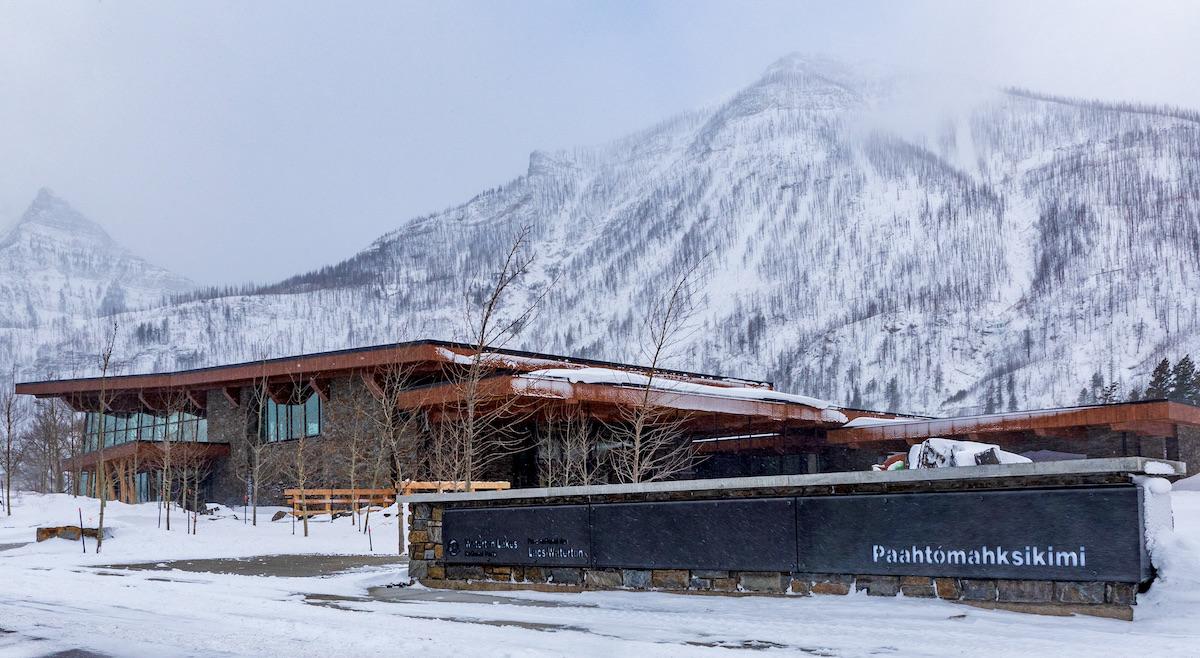
The new visitor center at Waterton Lakes National Park is nestled under Crandell Mountain/Parks Canada
Waterton Lakes National Park has a new visitor center designed with climate change mitigation and sustainable infrastructure in mind.
The year-round center features electric vehicle charging, a walkable location in Waterton townsite, ample natural daylight, efficient plumbing fixtures, sustainable rainwater management and responsibly sourced construction materials.
It boasts modern interpretive exhibits, interpretive programming and visitor information services. Exhibits highlight the area’s biodiversity and unique landscapes, and the forces of nature (like wind and wildfire) that shape them.

Inside the new visitor center at Waterton Lakes National Park/Parks Canada
Featured exhibits include:
- Night life theatre: A short, looping animation that highlights the park’s nocturnal wildlife and starry skies.
- Forces of nature: A short looping animation and soundscape depicting natural forces in Waterton Lakes, including wildfire and recovery.
- Biodiversity walls: Two walls that show off the park’s distinct ecosystems, including the alpine, subalpine, montane forest, grassland and aquatic ecosystems.
The previous visitor center was destroyed during the Kenow wildfire in 2017, which burned about 19,000 hectares (48,000 acres) in the national park. Parks Canada opened a temporary location next to the post office since the fire, but say the new visitor center was already in development prior to the wildfire. "The old center was slated for replacement as it no longer met the needs of the park prior to the fire, and we already had the infrastructure funding in place to build the new one," says Dallas Meidinger, partnering, engagement and communications officer for the Waterton Lakes Field Unit.
Waterton Lakes is in Treaty 7 territory and has long been a place of significance for the region’s Indigenous peoples, including the Siksikaitsitapi (Blackfoot) peoples. Parks Canada worked with Indigenous partners to ensure the materials developed reflect local Indigenous history, traditions, culture and connection to Waterton Lakes (Paahtómahksikimi or inner sacred lake in the mountains)

The new visitor center also bears the park's Indigenous name/Parks Canada
About $103 million Canadian ($81 million USD) has been invested in projects here through the Federal Infrastructure Investment Program to support "high-quality and meaningful visitor experiences" and help protect the environment. The visitor center represents a significant investment under this program.
“This landmark project in Waterton Lakes National Park is an investment in the future that will welcome Canadians and visitors from around the world for years to come, providing them with opportunities to learn about the park’s environmental and cultural significance, including the area’s importance to local Indigenous communities,” Minister of Environment and Climate Change and Minister responsible for Parks Canada Steven Guilbeault said in a news release.
Waterton Lakes is in Alberta where steep mountains abruptly meet the prairie. Along with Glacier National Park in Montana, it holds three joint designations: International Peace Park, World Heritage Site, and the first transboundary International Dark Sky Park (certified by the International Dark Sky Association). Both parks are also a part of broader Biosphere Reserves.

 Support Essential Coverage of Essential Places
Support Essential Coverage of Essential Places




Add comment